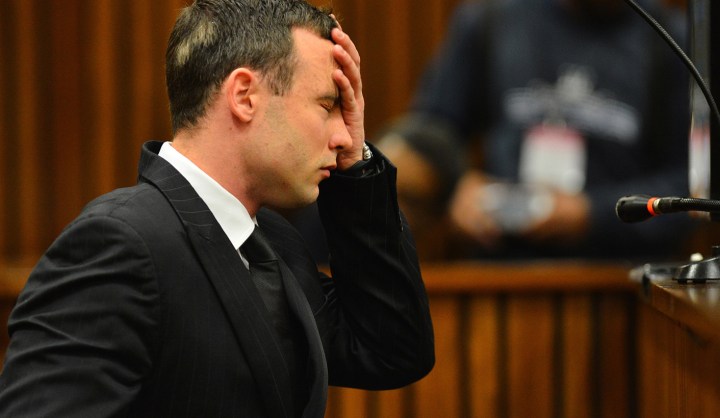Maverick Life
Pistorius Trial: Week Ten, Day Two

On Monday the North Gauteng High Court heard that Oscar Pistorius was not suffering from a mental disorder which compromised his ability to distinguish right from wrong when he shot Reeva Steenkamp in February last year. That was the finding of a panel of experts who assessed the athlete for 30 days. With that matter put on ice for now, we’re working through the defence team’s final few witnesses. By REBECCA DAVIS
09.00 When things wrapped up at the North Gauteng High Court on Monday, acoustics expert Ivan Lin had just finished being led through his evidence by the defence’s Barry Roux. Not that there was a great deal of “leading” going on, with Roux allowing his witness to rattle off a string of figures before delivering his conclusion – that from a distance of 177m from Pistorius’s house, it may have been impossible for witnesses to have heard the screams that they claim.
First up this morning will be the prosecution’s Gerrie Nel with his cross-examination of Lin. Once Lin is released from the stand, there may only be one defence witness left to call. But we’ve been surprised on numerous occasions before during this trial, so let’s not put money on anything just yet.
11.15 It’s a slightly delayed tea break at the North Gauteng High Court, where the rapid dispatching of defence witnesses continues.
As expected, matters kicked off today with the state’s Gerrie Nel cross-examining acoustics expert Ivan Lin. Nel had clearly had a busy night with his team researching sound-related issues.
From Lin Nel extracted the fact that he had compiled his sound report only over the last two weeks – again raising the question of why so much of the defence work is being undertaken so last-minute. Nel pointed out that the topography of the Pistorius’s estate has changed considerably since the shooting in February last year: new houses have been built and trees have grown. We heard from Lin himself yesterday that even minor environmental changes may cause sound to be perceived differently. Lin said that he was aware of these changes because he had seen them for himself when he visited the estate.
Lin said that he did not visit the houses of neighbour witnesses the Stipps and the Burgers, but he was shown photographs of their houses. He had visited Pistorius’s former home, however. (The house has been sold, but is apparently still empty at the moment.)
Under questioning, Lin conceded that it is “common sense” that “more often than not” people can tell male from female screams, though he stressed that this was very much not always the case in reality. He agreed that it was “commonly known” that women’s voices have a higher pitch.
He rejected the suggestion by Nel that hard surfaces in Pistorius’s bathroom, like tiles, could have amplified the sounds of screams.
Lin confirmed that if a listener was 80m away from someone screaming in a toilet – as the Stipps were – the sounds they heard would likely be “audible and intelligible”. By “intelligible”, he clarified that he meant that the sounds could be “understood”, but not necessarily that the listener could tell whether it was a male or female producing them.
Nel hammered home the fact that four state witnesses identified the sounds they heard on the morning of 14 February 2013 as a woman screaming.
“I cannot say if they were correct or incorrect,” Lin said.
In short, then, Lin’s testimony cast doubt on the ability of the state’s neighbour witnesses to precisely interpret what they thought they heard on the evening of Steenkamp’s shooting. But he also could not exclude the possibility that the Stipps, at least, did indeed hear what they thought they did.
It’s also unclear why the defence would call their only dedicated sound expert to the stand, and then not question him on the thorny matter of the sound similarities between gunshots and a cricket bat repeatedly striking a door. As it stands, we are left only with the testimony of the somewhat discredited Roger Dixon and forensic expert Wollie Wolmarans on that score – neither of whom have a specialization in acoustics.
The fifteenth witness called by the defence is Pistorius’s agent/manager Peet van Zyl, which explains why he hasn’t been supporting Pistorius in court up till now. Van Zyl seems to have been called to testify as to Pistorius’s general sense of fear and anxiety as to perceived threats of danger in his environment.
Van Zyl testified that Pistorius would drive very fast to the airport out of fear of being hijacked or followed; that he would always park in well-lit parking bays with easy access; that loud bangs startled him; and that he would barricade himself in hotel rooms overnight.
Van Zyl said that in all the time they worked together – since 2006 – he could recall only two occasions on which Pistorius had lost his temper, in both cases in response to invasive or aggressive questioning from the media.
He has also testified to Pistorius’s relationship with Reeva Steenkamp, saying that Pistorius had asked van Zyl for the first time if he could bring a girlfriend (Steenkamp) with him to overseas athletics fixtures, because he “wanted Miss Steenkamp to see what my world is about, the pressure I’m under”.
An “astute businessman”, Pistorius was aware shortly before the shooting that his financial future was looking very bright post-London Olympics. He knew that he stood to rake in serious money from shares and royalties in the companies sponsoring him.
13.00 An early end to proceedings in the Pistorius trial today, as Gerrie Nel has been granted time to prepare further questioning for defence witness Peet van Zyl.
When we resumed after the tea break, Nel was up for his cross-examination of van Zyl. He began by expressing surprise that the court had been confronted with character evidence about Pistorius through van Zyl’s testimony.
The rules around character evidence in South African law are fairly complex. There’s a helpful post on an SA criminal law blog, written in response to the Pistorius trial, which attempts to clarify the issue a bit.
“Ordinarily, evidence of the disposition of a person is inadmissible because it is simply irrelevant. We know that good people do bad things, and bad people do good things,” the author writes. However, there are grounds on which evidence of the accused’s character can be led. “The most prominent is where the accused leads evidence of his/her good character, the state may respond and present evidence of bad character,” they note.
In other words, because the defence has produced agent Peet van Zyl to testify as to Pistorius’s good character, the state is now allowed to counter this in cross-examination with evidence to the contrary. To open the door to character evidence is thus obviously a bit of a risky move, but one which the defence’s Barry Roux must have considered worth taking in this instance.
Dealing with van Zyl’s claim that he had only seen Pistorius lose his temper twice, Nel asked why van Zyl had not mentioned the occasion on which Pistorius called another athlete a cheat. Nel was referring here to the 2012 Paralympic Games, when Pistorius lost the 200m sprint to Brazilian Alan Oliveira, and thereafter ranted that it wasn’t a “fair race” because of the length of Oliveira’s blades.
Van Zyl replied that he had not mentioned it because he had not been present.
Nel also wanted to know why van Zyl had not mentioned the incident at the 2012 Olympics where Pistorius’s roommate had asked to be moved to a different room. Radio personality David O Sullivan wrote about this episode, saying that 100m athlete Arnu Fourie had told O Sullivan that he had requested to be moved “because Oscar was constantly screaming in anger at people on the phone”.
Van Zyl again said that he could not comment on the matter because he hadn’t been there. He also claimed not to have heard any reasons why Pistorius’s roommate had made the request to be moved – which some may find unlikely given that his role as Pistorius’s agent would presumably have required him to safeguard Pistorius’s reputation against harm to prevent fallout from sponsors.
Van Zyl also said that he had not discussed the specifics of Steenkamp’s shooting with Pistorius “at all. Not once.”
The agent testified that he had only become aware of Pistorius’s love for guns in November 2012, when he saw Pistorius wearing a gun in van Zyl’s own residence. When van Zyl asked Pistorius why he was carrying a gun, Pistorius replied that he feared for his safety.
Nel made reference to an article by a “British journalist” which claimed that Pistorius would visit a shooting range late at night when he couldn’t sleep. It seems that Nel meant this 2012 New York Times profile, which actually quotes Van Zyl:
The people around Pistorius worry about his risk-taking, but there’s only so much they can do. His manager, Peet van Zyl, shrugged when I asked him about it. “It’s the nature of the man,” he said. “At least we did get the motorbike away from him.
Van Zyl testified that he had not discussed the matter with Pistorius, and that he did not consider the article to have been particularly negative.
Nel asked van Zyl about Pistorius’s stated reasons for wanting to take Reeva Steenkamp to international athletics meets with him: so that Reeva could see Oscar’s world, understand the pressure Oscar was under, understand why Oscar couldn’t always attend the events Reeva wanted because he had to be up early for training. When reading back van Zyl’s testimony in this regard, Nel emphasized “I, Oscar” repeatedly: it has been his intention throughout to present Pistorius as narcissistic.
Nel’s main point here was different, though. He asked van Zyl if these reasons cited by Pistorius were not evidence of friction points between Pistorius and Steenkamp. Van Zyl denied this, saying it was quite normal for athletes to want to show their partners the conditions under which they had to work.
That’s where we left it for today. Tomorrow, Nel will continue grilling van Zyl. In particular, he may want to cast doubt on van Zyl’s claims not to have encountered a negative side to Oscar Pistorius, since van Zyl would have had to be alive to any potential negative publicity around Pistorius as his agent. Will Nel mention an incident like Pistorius’s 2009 Vaal River boating accident? Pistorius said on the stand that this accident occurred because the sun was in his eyes, but van Zyl said at the time that the accident took place because Pistorius was on the river “after dark”.
We also wait to see whether van Zyl is the final witness to be called by the defence, or whether at least one more will follow.
Meanwhile, BBC journalist Andrew Harding has tweeted that he has been “reliably informed” that the Pistorius psychologist report from Weskoppies says the athlete “did NOT have anxiety disorder”. If this is accurate, the testimony of defence witness Dr Merryll Vorster to the contrary is looking distinctly shaky. DM
Photo: South African Paralympic athlete Oscar Pistorius sits in the dock during his murder trial at the High Court in Pretoria, South Africa, 30 June 2014. Pistorius returned to court after spending 30 days under psychiatric observation to determine if he should be held criminally responsible for killing his girlfriend Reeva Steenkamp. He stands trial for the premeditated murder of his model girlfriend Reeva Steenkamp in February 2013. EPA/PHIL MAGAKOE/ POOL

















 Become an Insider
Become an Insider